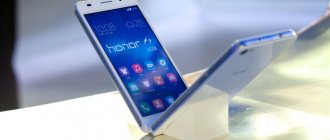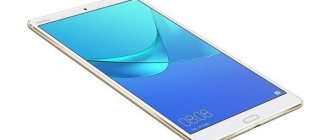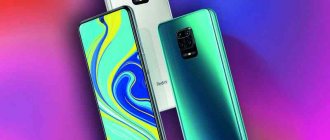Xiaomi or Huawei are two Chinese brands that have managed to conquer the CIS market, offering affordable smartphone models that are superior in performance to similar devices from Samsung, LG or Apple. Let's figure out which brand is better, taking into account the prices, advantages and disadvantages of phones from vendors. Additionally, we will compare popular models.
Price policy
The Xiaomi company attracts attention due to the low price of its devices, which the brand achieved through the introduction of advertising. Banners with commercial offers from partners appear:
- in system applications;
- folders on the desktop;
- lock screen.
You can disable built-in advertising through the settings of the pre-installed software.
In 2021, Xiaomi is releasing devices from the middle and top price segments. Until 2021, the brand developed the Redmi line of affordable smartphones, which split off from the company, becoming a sub-brand developing along its own path.
Huawei does not use advertising inside proprietary firmware, with the exception of pre-installed partner software. Because of this, the cost of individual models is higher than that of a competitor. The presence of Huawei's sub-brand in the person of Honor does not prevent the vendor from releasing both budget and flagship smartphones.
In September 2021, the United States imposed sanctions on the company, due to which the brand cannot:
- use Google services (Play Market, Google Pay, Gmail, Google);
- receive official updates to the Android operating system;
- cooperate with American companies, which led to a severance of relations with Taiwanese TSMC, which develops Kirin chipsets.
This led to the start of development by the vendor:
- own application store AppGallery;
- development of a proprietary operating system Harmony OS;
- restoring NFC operation through cooperation with online banks.
Imposing restrictions could lead to the emergence of an operating system competing with Android and iOS.
Specifications
When you need to find out whose device is more productive, when considering Huawei or Xiaomi, users tend to choose the second brand. The reasons for this attitude towards Xiaomi are as follows:
- the company installs current chipsets from Qualcomm Snapdragon in smartphones or uses powerful single-chip systems from MediaTek;
- cooperation with Samsung has opened access to the use of AMOLED matrices and current camera sensors in devices. Lenses are also supplied to the vendor by Sony.
The same model from Xiaomi, but in different batches, can use similar modules (camera from Samsung or Xiaomi, matrix from another manufacturer, etc.).
Before the restrictions, Huawei relied on its own Kirin chipsets. If the processor cores were not inferior in power to their Snapdragon counterparts, the Mali graphics chip could not compete with Adreno. At the same time, top-end Kirins from the 800 and 900 series are able to run demanding games at high graphics settings. In 2021, the production of its own platform is being phased out and the company is beginning to cooperate more with MediaTek, whose chips it previously used only in entry-level smartphones.
The main features of devices from Huawei in comparison with Xiaomi:
- an NFC module for cashless payment is found even among budget devices;
- the brand has to use the outdated Kirin 710/710F while the competitor installs the current Snapdragon from the 600 and 700 series;
- Only flagships from Huawei get cameras with Leica optics; in the mid-range and budget segments they use sensors of worse quality. Xiaomi installs up-to-date sensors that users complement by developing Google camera modifications for them that increase the quality of pictures.
Xiaomi smartphones: advantages
Price
The first thing a consumer looks at is the price of a smartphone. And if this criterion is the main one in the question of which phone to choose - Xiaomi or hHuawei, then preference will definitely be given to the first. Xiaomi, in principle, has no competitors in the budget segment. Moreover, you shouldn’t expect Huawei to release some kind of flagship for $300, while Xiaomi is proving the possibility of this, and not only in theory, but also in practice.
Autonomy
Even budget Xiaomi gadgets have very powerful batteries, the capacity of which often exceeds 4000 mAh. At the same time, it is possible to maintain an acceptable thickness of the case, which users clearly like, based on their reviews.
Excellent performance
Xiaomi doesn’t make its own hardware, but it puts high-quality foreign hardware into its smartphones. The company's flagships invariably find themselves in the top 10 in synthetic benchmark ratings. Xiaomi doesn’t have any cheap and weak gadgets at all, if you don’t take into account the junior model of the budget “four” Redmi 4A, but its price is less than $100.
Graphic shell
The advantages and disadvantages of MIUI and EMUI are subjective for each user. Important points:
- both interfaces may not work correctly at the start of smartphone sales;
- On Huawei devices, the bootloader is locked – you won’t be able to install custom firmware; Xiaomi unlocks the bootloader through an official form;
- Huawei device support period is limited to 2 years, Xiaomi – 3 years (the period depends on the model).
In August 2021, Xiaomi stopped producing devices from the Android One program on “pure Android” without a proprietary shell. The latest model is Mi A3.
Segment up to 15,000 rubles
Here are smartphones that are more productive than budget models, but not powerful enough to move into the mid-range segment.
Huawei P40 lite E
The youngest model from the flagship P40 series. The front panel of the device is occupied by a 6.39-inch screen with a resolution of 1560 x 720 and a bright IPS matrix. The front 8 MP camera is located in a drop-shaped notch. On the back panel, in addition to the fingerprint scanner, there is a block of three cameras of 48, 8 and 2 megapixels. Photos are of average quality.
The device runs on Kirin 710F in combination with 4/64 GB of memory, there is a slot for memory cards up to 512 GB. The 4,000 mAh battery is charged via an outdated microUSB port. For its price, the user also receives a 3.5 mm port for connecting wired headphones and NFC with the ability to pay for purchases through banking applications or Wallet programs.
Huawei P30 lite
Having overpaid 2000–3000 rubles, the user can buy P30 lite. Unlike the device mentioned above, this smartphone used a 6.15-inch IPS display with a resolution of 2312 x 1080 and a 32 MP front camera built into a drop-shaped notch. The composition of the main camera has been transformed and includes a 24-megapixel main module instead of the 48-megapixel analogue of the P40 light E.
The battery here is smaller - 3340 mAh, and Bluetooth 4.2 is used, which is due to the installed Kirin 710 chipset. Compensates for the shortcomings:
- USB Type-C charging connector with fast charging support;
- availability of dual-band Wi-Fi;
- availability of pre-installed Google services;
- support for memory cards up to 512 GB, complementing 4/128 GB of built-in storage.
Redmi Note 8T
The only model with which it is possible to compare previous devices is the Redmi Note 8T from the Xiaomi sub-brand. Device features:
- 6.3-inch display with a resolution of 2340 x 1080 and IPS matrix;
- 4000 mAh battery with support for fast charging via USB Type-C;
- 4 lenses in the main unit: 48, 8, 2 and 2 megapixels;
- 13 MP front camera;
- 8-core Snapdragon 665.
The difference from the regular Redmi Note 8 is the increased body size and the presence of NFC.
Segment up to 20,000 rubles
This includes sub-flagship models, distinguished by powerful characteristics and design close to top-end devices.
Huawei P40 lite
The appearance of the P40 lite brought the 8-core Kirin 810 to the Russian market - a direct competitor to the Snapdragon 730/732. The front panel is occupied by a 6.4-inch display with a resolution of 2340 x 1080 and an IPS matrix. The selfie lens is placed in a hole in the upper left corner of the display. The main camera is made in the form of a rounded square and accommodates 4 sensors: 48, 8, 2 and 2 megapixels. The chipset is compatible with dual-band Wi-Fi, Bluetooth 5.0 and NFC.
The memory version is available in 6 GB RAM and 128 GB ROM, and there is a slot for a memory card up to 256 GB. The device is powered by a 4200 mAh battery. From a unit that supports Huawei SuperCharge fast charging via USB Type-C, the battery is restored to 100% in 1 hour. The Android 10 operating system works without Google services.
Huawei P20 Pro
When it comes to choosing from ex-flagships, the P20 Pro is the best choice with its 6.1-inch AMOLED display with a resolution of 2240 x 1080 and a notch for a 24MP selfie camera. The device case is protected according to the IP67 standard, which allows it to withstand short-term immersion in water. When watching video or playing audio, audio is transmitted in stereo mode.
The 8-core Kirin 970 with 6 GB of RAM and 128 GB of storage is responsible for performance. The power is enough to run top games at medium graphics settings. The device runs on a 4000 mAh battery with support for fast charging. On the back of the body there are 3 cameras with a resolution of 40, 20 and 8 megapixels, there is support for optical video stabilization.
It is impossible to imagine a Xiaomi device against devices from Huawei, since only Redmi Note 8 Pro or Note 9 are available in this price segment.
Features of manufacturers Huawei, Honor and Xiaomi
Devices from the Middle Kingdom are very popular among users. The phrase “Chinese smartphone” has long ceased to be associated with something cheap and low-quality. Now manufacturers from the East Asian country are trying to produce devices that are in no way inferior to the well-deserved market leaders Samsung and Apple.
Of the countless Chinese companies, the brands Huawei and Xiaomi stand out.
Xiaomi is a young company founded in 2010. From the very beginning of its existence, the company began producing inexpensive smartphones, and just a few years later it became a leader in terms of sales. Decent flagships have appeared in the lineup, ready to repel the same opponents from Apple.
Huawei, in turn, is one of the oldest corporations by modern standards. The company began operating in 1987 and at the beginning of its existence was not in particular demand among foreign buyers. In the 2010s, the situation changed dramatically, and now Huawei smartphones are considered the best in terms of cameras.
Speaking about Huawei, we cannot fail to mention the Honor sub-brand. This is a junior division of the company, the appearance of which, as planned by the head office, was supposed to win an even larger audience. In fact, this is what happened. As of 2021, Huawei and Honor smartphones are selling millions of copies, surpassing Samsung, Apple, and Xiaomi in this indicator.
But what is the difference between Honor and Huawei? The fact is that Honor is a brand aimed at a young audience. The line of devices includes relatively inexpensive models that both students and beginning workers can afford. Honor also has flagships, but Huawei still offers more advanced devices. That is why in today’s material we will not consider Honor smartphones, but will focus on Huawei products.
Xiaomi has also recently got a younger brother. This is the Redmi brand, which in its positioning copies Honor. Of course, Redmi smartphones have existed almost since the very appearance of Xiaomi, but only in 2021 the company differentiated the brands, and the buyer will not see a reminder of Xiaomi on the body of the conventional Redmi Note 8 Pro.
In addition to Redmi, Xiaomi has divisions Poco and Black Shark, which produce gaming smartphones.
The main brands Xiaomi and Huawei, which we will talk about today, are very similar to each other. These are two companies that offer smartphones in a wide range of price categories: from ultra-low-cost smartphones to the latest flagships. However, there are still differences between Xiaomi and Huawei. A detailed comparison of companies and the features of their models will make it clear which company’s smartphone is really worth purchasing.
Top price segment
A haven for pre-flagship and flagship devices with not always top-end characteristics. Since each manufacturer offers 3–6 devices in this price category, we will briefly mention each one.
Smartphones from Huawei
Nova 5T became the prototype of Honor 20. This applies to the IPS display, a dot cutout for the selfie camera in the upper left corner, and a main camera unit consisting of 4 lenses. The advantage of the device is its 3750 mAh battery, powerful Kirin 980 and support for Google services. At the same time, it is more affordable than the Mi 9T/9 SE/Note 10, which are discussed below.
Huawei P30 and P30 Pro are full-fledged flagships that retain their uniqueness due to the Kirin 980, support for Google services, and protection from moisture and dust. Other advantages: optical stabilization, support for fast charging and OLED displays.
Smartphones from Xiaomi
Mi 9 SE is a full-fledged compact based on the now obsolete Snapdragon 712, with a 5.97-inch diagonal AMOLED display and an IR port. Miniature forms led to a reduction in battery to 3070 mAh. The low capacity is compensated by support for QC4+ fast charging, which restores the battery to 100% in 1 hour.
Mi 9T, released under the Redmi brand in China, differs from all the above-mentioned smartphones by the presence of a periscope selfie camera that slides in and out of the device’s body. This avoided notches on the 6.39-inch AMOLED display. Otherwise, users get a Snapdragon 730, a 4000 mAh battery and a 3.5 mm headphone jack.
Mi Note 10 and Mi Note 10 Pro are two camera phones built on the Snapdragon 730G, with AMOLED screens, capacious 5260 mAh batteries, with support for fast charging and 5 cameras on the rear panel. The difference between the devices is the amount of maximum memory, the number of lenses of the main camera (7 vs. and the presence of laser autofocus in the Pro-shka.
The difference between the devices is the amount of maximum memory, the number of lenses of the main camera (7 vs. and the presence of laser autofocus in the Pro-shka.
Xiaomi Mi 9T Pro and Mi 9 are in the top-end flagship segment with Snapdragon 855 on board. The devices have the same 6.39-inch AMOLED displays and 3 cameras on the back. But, despite the similarities, the championship remains with the 9T Pro with its 4000 mAh battery versus 3300 mAh and a periscope camera that frees the screen from unnecessary cutouts.
Comparison of Xiaomi and Huawei phones
To understand which brand’s smartphone is better, you need to carefully consider all the features from performance to battery life. For an objective comparison, we did not pay attention to the Honor and Redmi lines, focusing on the main brands. At the same time, both expensive and very affordable models were considered.
Performance
Power or performance is one of the main characteristics of a smartphone. It determines how smoothly the device will operate and whether it can handle resource-intensive games. As a rule, the power of the phone is determined by the processor.
Huawei smartphones are equipped with self-produced chips, while Xiaomi uses MediaTek and Snapdragon processors. Comparing the two most affordable models (Huawei Y6 and Xiaomi Mi Play), it is not possible to notice much difference in performance.
If we turn to the segment of mid-budget devices, where a comparison of Huawei P30 Lite and Xiaomi Mi A3 suggests itself, then Xiaomi will have an undoubted advantage. The Snapdragon 665 chipset is significantly faster than the Kirin processor and also demonstrates greater stability.
In the flagship segment, both brands are trying to install the most powerful processors. In the case of Huawei, this is, of course, Kirin, and Xiaomi opts for Snapdragon. The 2 latest models from the manufacturers Huawei P40 Pro and Xiaomi Mi 10 Pro are really very good at games and demonstrate an enviably smooth interface. But in synthetic tests, the Snapdragon 865 wins the unconditional victory, gaining almost 100 thousand points more in the AnTuTu benchmark compared to the Kirin 990.
Based on models of different price segments, we can conclude that Xiaomi smartphones are more powerful in almost every class. This is due to the use of more advanced chips from Qualcomm, which are the best on the Android device market.
Despite all the advantages of Qualcomm processors, they are still inferior to Apple chipsets. For example, the one installed in the iPhone 11 Pro.
Design and management
Both manufacturers pay serious attention to the design of their devices. Xiaomi and Huawei are in leading positions in this direction, as the companies set trends in the industry.
If you put the average Huawei and Xiaomi next to each other, you will not be able to detect the difference except for the brand logo. The model range of both companies includes smartphones with a retractable camera (Huawei P Smart Z and Xiaomi Mi 9T), models with a drop-shaped notch, and those devices where the front camera module is literally embedded in the display (Huawei Nova 5T and Xiaomi Mi 10).
The design of the back cover of the two comparison participants is also identical. In the budget class, colorful plastic is used, and in more expensive models, manufacturers try to install a glass cover with a gradient. In all cases, smartphones look very beautiful, so it’s impossible to give preference to a specific brand.
There is no need to talk about management at all. In 2021, almost all companies producing Android smartphones have abandoned touch control keys. In this regard, control is carried out using on-screen buttons or gestures.
Display
Without exaggeration, the screen can be called the face of a smartphone. The buyer’s overall impression of the device depends on how clearly and colorfully the picture is displayed.
The cheapest Xiaomi and Huawei models have IPS matrices with HD+ resolution. In principle, this is a good solution, but due to the low pixel density, the screen grain is noticeable. In more expensive smartphones, the resolution increases to FullHD+, but the type of matrix remains the same. The exception is the Xiaomi Mi A3, which for a price tag of around 10 thousand rubles offers an AMOLED screen, but with HD+ resolution.
Despite the advantage of AMOLED matrices in terms of color reproduction, such screens flicker heavily, which can cause eye fatigue for the owner.
The flagship segment is a field for experimentation for each manufacturer. Of course, Xiaomi and Huawei are not abandoning the use of AMOLED matrices here, but they are trying to bring something new. For example, Xiaomi Mi 10 and Huawei P40 Pro have a curved waterfall screen. This solution looks extremely impressive, and the picture quality does not raise any questions.
Since almost all companies on the market use matrices from the same manufacturers, it is impossible to say that the Huawei or Xiaomi display is better. Both companies offer displays of comparable quality, but Xiaomi experiments more often than its competitor.
Cameras
Perhaps the main characteristic that forces the buyer to choose one or another model. Here we will not consider budget and mid-budget smartphones, but will immediately turn to the most advanced flagships of Huawei and Xiaomi.
Let's compare Huawei P40 Pro and Xiaomi Mi 10 Pro. The first model is equipped with a 40-megapixel main camera with a wide (40 MP), a telephoto lens (12 MP) and a ToF sensor. The smartphone takes cool pictures both during the day and in the evening, and also records video in 4K 60fps.
The Xiaomi device is equipped with a 108-megapixel main camera with 10x optical zoom. These are incredible figures for a smartphone, especially since the device records video in 8K. The wide-angle lens is slightly inferior in quality to the Huawei device, but all other things being equal, it is the Xiaomi flagship that wins the camera comparison. This fact is a little surprising, since until recently Huawei was considered the undisputed leader in photo and video.
Battery
Smartphone batteries from different brands are no different from each other. In both cases, lithium polymer batteries are used, which are lightweight and charge quickly.
But in terms of specific capacity, Xiaomi devices win. Smartphones from the two companies, which have identical prices and a set of basic characteristics, have batteries of different sizes. Xiaomi tries to install the largest batteries, as it did in the Xiaomi Mi Max 3 (5500 mAh). The competitor's maximum rating is 5000 mAh.
Software
In most cases, manufacturers use proprietary software. Xiaomi has MIUI, Huawei has EMUI. The design of the shells is different, but it will be difficult to say which firmware is more convenient. But Xiaomi's OS has a significant drawback - the presence of built-in advertising. Offers from partners appear in all standard programs, so the victory in this category is awarded to Huawei.
The Xiaomi line of devices includes smartphones that are based on pure Android. This is the Xiaomi Mi A series.
Signal quality
Huawei and Xiaomi, which are sold in Russia, are localized and are excellent for use in our latitudes. Smartphones catch 4G wherever there is support for fourth generation networks. In addition, both companies began releasing models with 5G in 2021, but this technology is not yet used in Russia.
Working hours
When assessing the autonomy of devices, we have to return to comparing batteries. As we found out earlier, Xiaomi installs larger batteries, and Snapdragon processors have better energy efficiency. In this regard, the conditional flagship Xiaomi Mi 10 will last longer than the Huawei P40.
Memory
Built-in storage is a controversial thing, since in the budget segment you cannot find a model with a memory capacity of over 64 GB. But almost all Xiaomi and Huawei flagships have modifications of 256 and even 512 gigabytes. But the victory in this comparison goes to Huawei, since the competitor refuses to use a memory card slot in older models.
Phone capabilities
Xiaomi and Huawei really know how to surprise. Manufacturers often equip their devices with advanced features that were not previously available. Smartphones from both companies are equipped with modern security features (fingerprint scanner), interesting solutions (retractable front camera), as well as an NFC module for making contactless payments. It is impossible to give victory to anyone in this comparison. Both Huawei and Xiaomi equip models of different price segments with all the necessary functions.
All other things being equal, only Huawei has a smartphone with a bendable screen - Huawei Mate X. Xiaomi does not have such a gadget.
Build quality
Huawei and Xiaomi carefully monitor all stages of the smartphone manufacturing process. That’s why the gadgets from the two companies turn out to be of such high quality. You can only find fault with the assembly in the case of the cheapest models that use plastic. But in more expensive devices it is impossible to find fault with the assembly of Huawei and Xiaomi.











